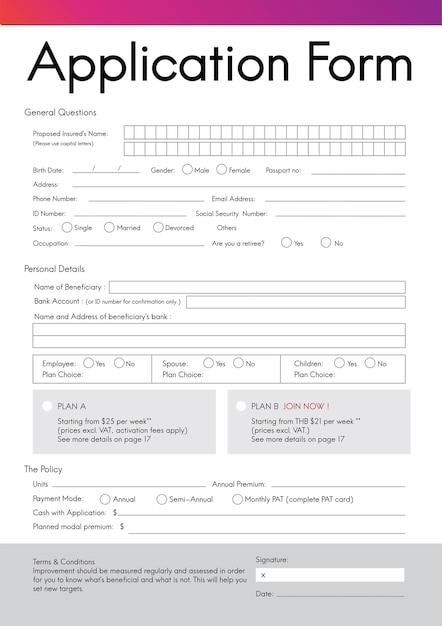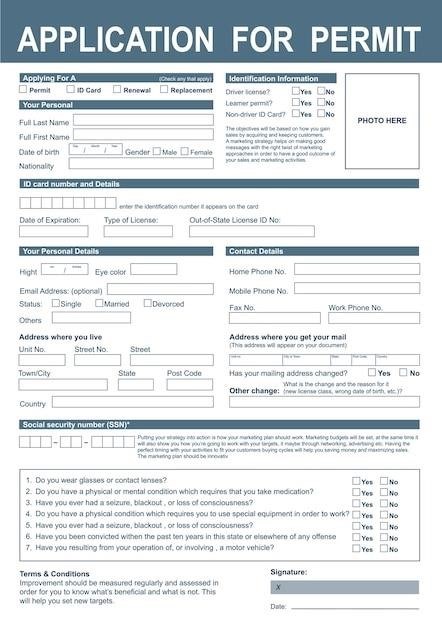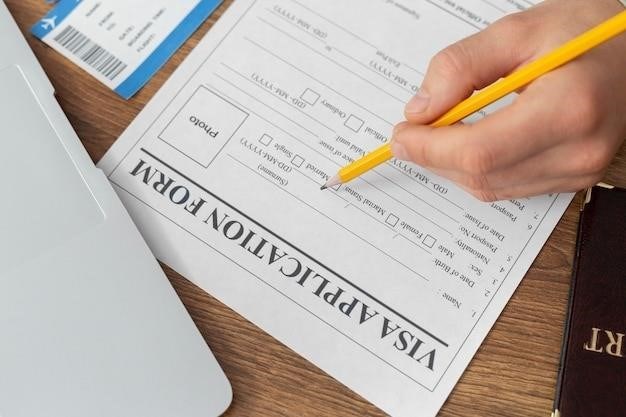Understanding the Illinois Hardship License (RDP)
An Illinois Restricted Driving Permit (RDP), commonly known as a hardship license, allows driving privileges to individuals whose licenses are suspended or revoked due to various offenses. It’s a limited driving privilege granted by the Illinois Secretary of State, offering a pathway to regain some driving abilities while facing specific restrictions. The RDP is not a full license replacement but a temporary measure to address compelling circumstances, such as employment or essential needs. Eligibility depends on demonstrating extreme hardship and posing no public safety risk.
What is an Illinois Hardship License?
In Illinois, a hardship license, officially termed a Restricted Driving Permit (RDP), is a limited driving privilege granted by the Secretary of State to drivers facing license suspension or revocation. It’s not a full license reinstatement; rather, it allows driving under specific conditions and limitations, often tied to essential needs like work, medical appointments, or childcare. The RDP aims to balance the need for mobility with public safety concerns. Eligibility requires demonstrating extreme hardship caused by the license loss and proving the driver poses no significant risk to public safety. The permit’s restrictions vary depending on the individual’s circumstances and the severity of the offense that led to the license suspension or revocation. The RDP application process involves a hearing to determine eligibility and the specific terms of the permit. It’s crucial to understand that an RDP is a conditional privilege, not a right, and adherence to its terms is mandatory.
Eligibility Requirements for an RDP
Securing an Illinois Restricted Driving Permit (RDP) demands fulfilling stringent eligibility criteria; Applicants must demonstrate a compelling need for driving privileges, showcasing significant hardship resulting from license suspension or revocation. This hardship often involves essential travel for work, medical treatment, or childcare, but simply needing a vehicle is insufficient. The Secretary of State assesses each case individually, examining the nature of the offense leading to license loss and the applicant’s driving history. A clean driving record following the offense significantly improves chances of approval. Furthermore, applicants must prove they won’t endanger public safety. This often involves providing evidence of completing alcohol or drug rehabilitation programs, if applicable, and adhering to any court-mandated requirements. The process also includes an administrative hearing, where the applicant presents their case and answers questions from the hearing officer; Meeting these requirements doesn’t guarantee approval; the final decision rests with the Secretary of State.
Types of Restricted Driving Permits (RDPs)
Illinois offers various Restricted Driving Permits (RDPs), each tailored to specific circumstances. The most common type allows driving only for work, medical appointments, or essential errands within a defined radius of the applicant’s home; Restrictions might include driving only during specific hours or days, limiting mileage, or mandating the use of a Breath Alcohol Ignition Interlock Device (BAIID). Another RDP category may cater to individuals attending court-mandated programs, such as substance abuse treatment or community service. The Secretary of State determines the permit type based on individual needs and the severity of the offense that caused the license suspension or revocation. Some RDPs might be granted temporarily, while others may be extended for a longer duration. The level of restriction directly correlates with the applicant’s demonstrated need and the potential risk to public safety. The precise details of any limitations are outlined in the issued permit, leaving no room for ambiguity. The availability of different RDP types ensures that the Secretary of State can address a range of situations while maintaining public safety.

Applying for an Illinois Hardship License
Securing an Illinois hardship license, or Restricted Driving Permit (RDP), involves a formal application process. This process includes submitting a formal request for a hearing before the Illinois Secretary of State, presenting supporting documentation, and attending a hearing to demonstrate the need for the restricted driving privileges.
The Application Process⁚ Steps to Follow
The application process for an Illinois hardship license begins with a formal request for an administrative hearing with the Illinois Secretary of State. This request must be submitted in writing and may require specific forms, such as form DAH H 12, depending on the circumstances. After submitting the application, you will need to gather and submit all required documentation. This documentation may vary depending on the individual case and the reason for license suspension or revocation. It’s crucial to provide comprehensive and compelling evidence of the hardship you face without driving privileges and your commitment to safe driving practices. The Secretary of State will review your application and documentation; a hearing may be scheduled for an in-person or informal review of your case. Following the hearing, a decision will be made regarding your eligibility for an RDP. This decision, including any specific conditions or restrictions, will be communicated to you in writing. The entire process typically takes several weeks and requires careful preparation and documentation.
Required Documentation for Your Application
To support your Illinois hardship license application, compile thorough documentation showcasing your need for driving privileges. This typically includes court documents related to the driving offense that led to license suspension or revocation. Provide proof of employment, including a letter from your employer confirming your job, work schedule, and the necessity of driving for your position. If applicable, include documentation demonstrating the unavailability of alternative transportation options, such as public transit schedules or distance calculations. For medical reasons, supply medical records outlining the necessity of driving for appointments or treatment. Similarly, for childcare or eldercare needs, provide relevant documentation such as custody papers or medical records. Include any other evidence demonstrating your extreme hardship and the inability to manage daily life without driving. Be prepared to provide a comprehensive explanation detailing how an RDP will address your specific needs while ensuring public safety. Thorough and well-organized documentation significantly improves your chances of approval.
Administrative Hearing and its Outcomes
After submitting your Illinois hardship license application, you’ll likely face an administrative hearing before a Secretary of State hearing officer. This hearing serves to assess your eligibility for an RDP based on the presented evidence of hardship and public safety considerations; Prepare to present your case clearly and concisely, emphasizing the compelling reasons necessitating driving privileges. You must demonstrate how the RDP will directly address your specific hardship while mitigating any potential risks to public safety. The hearing officer will review your documentation and may ask clarifying questions. Three potential outcomes exist⁚ full license reinstatement, denial of your application, or the granting of a restricted driving permit. The decision is based on the totality of the information presented. You’ll receive notification of the outcome by mail within approximately 90 days of the hearing. If denied, you may be eligible for a subsequent hearing after a specified waiting period, allowing you to address the reasons for the denial. Legal representation can significantly enhance your chances of a favorable outcome.

Driving Restrictions and Conditions
Illinois Restricted Driving Permits (RDPs) impose limitations on driving time, location, and purpose. Some RDPs mandate the installation of a Breath Alcohol Ignition Interlock Device (BAIID). These restrictions aim to ensure public safety while granting limited driving privileges to those facing hardship.
Limitations and Restrictions of an RDP
An Illinois Restricted Driving Permit (RDP), or hardship license, comes with significant limitations. Driving is often restricted to specific times and days, frequently limiting travel to only essential trips like commuting to work or attending necessary appointments. The permitted driving radius might be confined to a certain distance from the driver’s home, preventing longer journeys. Mileage limitations might also be imposed, restricting the total number of miles driven within a specified period. Furthermore, the type of vehicle permitted might be restricted, often excluding certain classes of vehicles. The Secretary of State might mandate the use of a monitoring device, such as a Breath Alcohol Ignition Interlock Device (BAIID), for certain RDPs, requiring regular maintenance and adherence to strict guidelines. Violation of any of these restrictions can result in the immediate revocation of the RDP and potential legal consequences. Therefore, careful adherence to the terms of the permit is crucial for maintaining driving privileges.
Monitoring Devices and BAIID Requirements
The Illinois Secretary of State may mandate the installation of a monitoring device, most commonly a Breath Alcohol Ignition Interlock Device (BAIID), as a condition of receiving a Restricted Driving Permit (RDP); A BAIID is a device fitted into a vehicle that requires the driver to provide a breath sample before starting the engine. The device analyzes the breath sample for alcohol and prevents the vehicle from starting if the blood alcohol content (BAC) exceeds a pre-set limit. Regular maintenance and calibration of the BAIID are typically required, and the driver is responsible for the costs associated with its installation and upkeep. Failure to comply with BAIID requirements, such as missed calibrations or attempts to circumvent the device, can lead to immediate suspension or revocation of the RDP. The specific requirements for BAIID installation and usage are determined on a case-by-case basis by the Secretary of State, considering the individual’s circumstances and the nature of the driving offense. It’s crucial to understand and fully comply with all BAIID-related stipulations to maintain driving privileges under the RDP.
Duration and Renewal of the Hardship License
The duration of an Illinois Restricted Driving Permit (RDP), or hardship license, is determined on a case-by-case basis by the Secretary of State and is directly tied to the length of the underlying license suspension or revocation. Generally, the RDP is valid for a portion of the total suspension period, often requiring completion of a significant percentage (e.g., 75%) of the permit’s duration before full license reinstatement is considered. Renewal of an RDP is not automatic and depends on continued compliance with all conditions imposed by the Secretary of State. Factors influencing renewal decisions include the driver’s adherence to the RDP’s limitations, any violations committed during the permit’s validity, and whether the underlying reasons for the license suspension or revocation have been adequately addressed. Drivers must demonstrate continued adherence to the terms and conditions of the RDP, including any requirements for alcohol or drug treatment, community service, or the use of a BAIID. Failure to maintain compliance may result in the RDP’s revocation before the specified expiration date. The application process for renewal may involve submitting updated documentation and potentially attending another administrative hearing.
